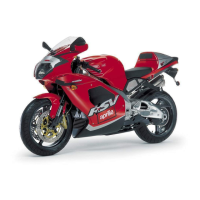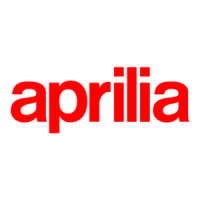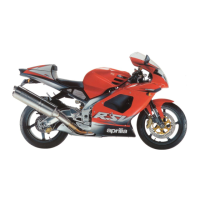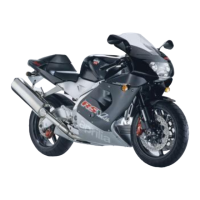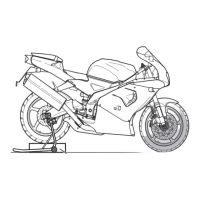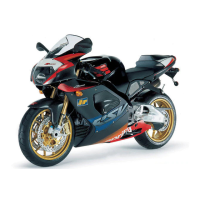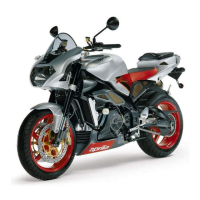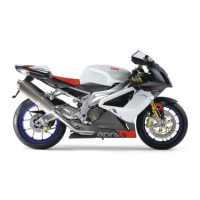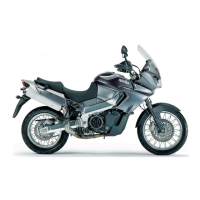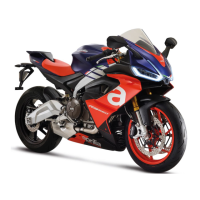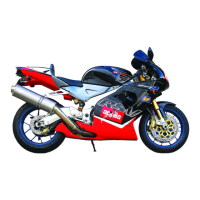
Do you have a question about the APRILIA RSV MILLE - PART 1 2000 and is the answer not in the manual?
| Year | 2000 |
|---|---|
| Manufacturer | Aprilia |
| Model | RSV Mille |
| Category | Sportbike |
| Fuel System | Electronic Fuel Injection |
| Cooling System | Liquid |
| Transmission | 6-speed |
| Front Tire | 120/70 ZR17 |
| Rear Tire | 190/50 ZR17 |
| Dry Weight | 189 kg (417 lbs) |
| Engine Type | 998 cc, 4-stroke, 60° V-Twin |
| Bore x Stroke | 97 x 67.5 mm |
| Power | 130 hp |
| Torque | 101 Nm (74.5 ft. lbs) @ 7200 rpm |
| Ignition | Digital |
| Frame | Aluminum |
| Rear Suspension | Mono-shock |
| Front Brakes | Dual 320mm discs, 4-piston calipers |
| Rear Brakes | Single 220mm disc, 2-piston caliper |
| Wheelbase | 1410 mm (55.5 in) |
| Front Suspension | Showa upside-down fork, adjustable preload, compression and rebound damping |
Describes the meaning of warning, caution, and note symbols used in the manual.
Pre-drive preparation, rider safety factors, and importance of vehicle knowledge.
Possession of license, age, insurance, taxes, and registration is mandatory.
Learn to ride in low-traffic or private areas first.
Avoid driving under influence of drugs, alcohol, or fatigue.
Never lend to inexperienced riders; ensure driver qualification.
Adhere strictly to all traffic signs and local road rules.
Prevent dangerous movements like wheelies or sudden acceleration.
Steer clear of objects that could cause loss of control.
Maintain correct posture with hands on handlebars and feet on footrests.
Focus on driving; avoid smoking, eating, reading, etc.
Use specified fuels/lubricants; check levels regularly.
Ensure no damage to controls, frame, or vital parts.
Inform technicians of any malfunctions for assistance.
Use a properly fitted, homologated helmet with a clean visor.
Wear bright, reflective clothing for visibility and fall protection.
Snug fit, secure fastenings, no loose items.
Flammability, ventilation, no smoking, no flames.
Specifies unleaded petrol, O.N. 95.
Steps for opening tank, inserting key, and refueling safely.
Total capacity and reserve fuel quantity.
Separate circuits for front and rear brakes.
Potential causes for resistance or clearance problems.
Ensure discs are clean, cables are not worn.
Avoid skin/eye contact; wash affected areas immediately.
Brakes are critical; check before every trip.
Cleaning discs, replacing worn pads.
Change every two years by an Aprilia dealer.
Double disc front, single disc rear.
Ensure level is between MIN and MAX marks.
Steps for adding fluid, including precautions.
Ensure level is between MIN and MAX marks.
Explains level drop as pads wear.
Steps for adding fluid, including precautions.
Vehicle uses hydraulic clutch control for smooth operation.
Potential causes for resistance or clearance problems.
Change every two years using specified fluid.
Ensure level is between MIN and MAX marks.
Explains level drop and need for topping up.
Steps for adding fluid, including precautions.
Do not use vehicle below minimum level.
Warnings about swallowing, skin/eye contact.
50% water, 50% antifreeze for optimal performance.
Essential for safety and early detection of anomalies.
Indicates electronic system faults detected by the unit.
"SERVICE" message indication and procedure to clear.
Levers, fluid level, leaks, pad wear verification.
Accelerator, oil, chain, fuel, coolant checks.
Tyres, lights, horn, and electrical device functionality.
